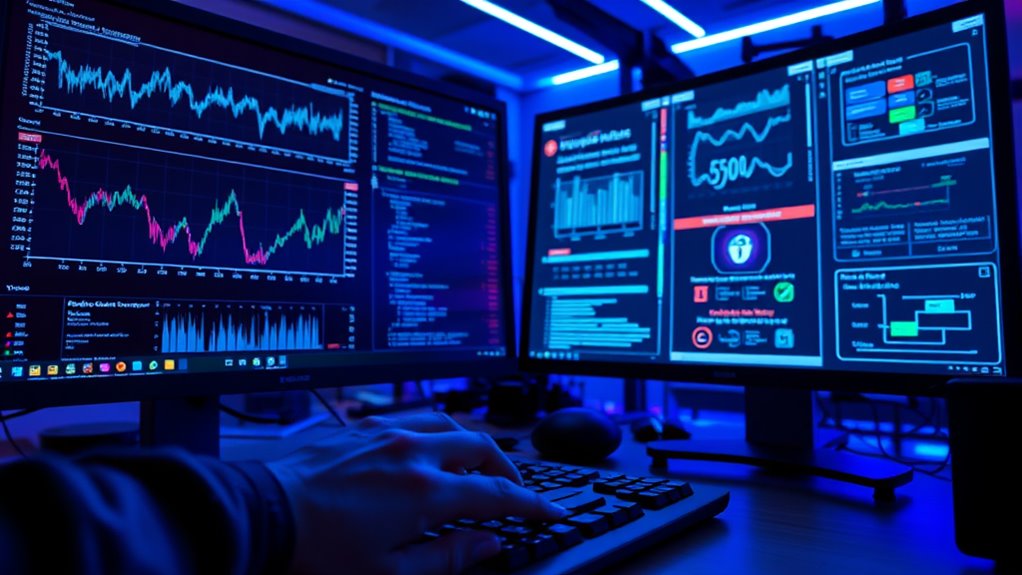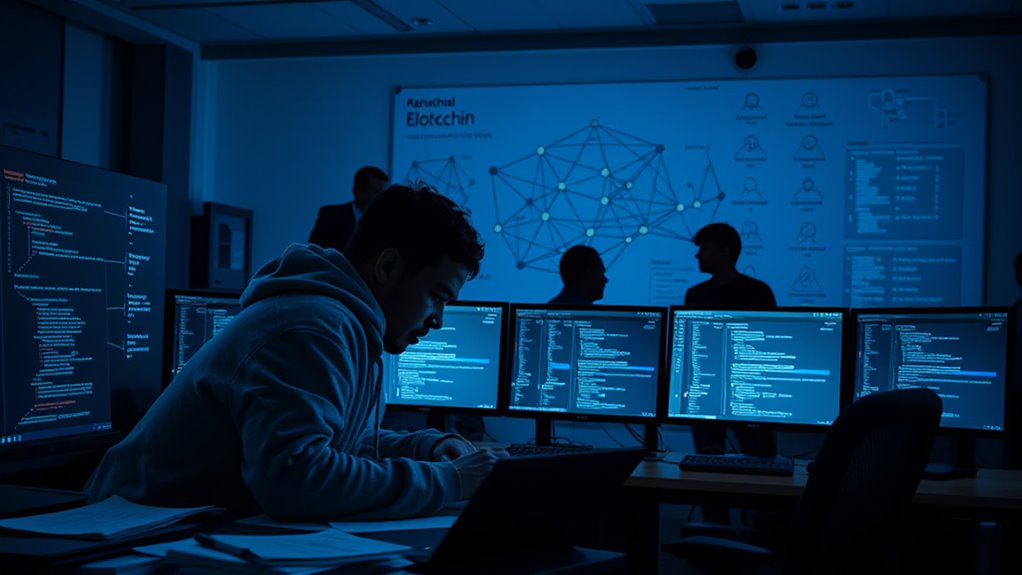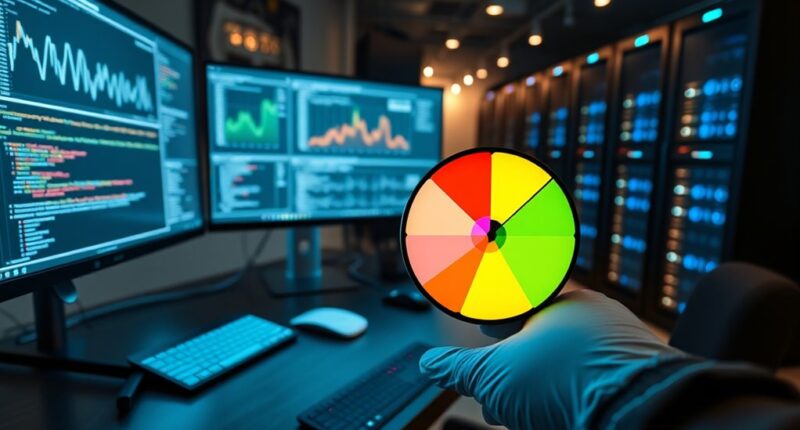DeFi platforms claim decentralization, but the evidence suggests otherwise. You’ll find that control often resides with early investors, large token holders, and core developers, who influence decisions and upgrades. Centralized infrastructure, like front-end interfaces and cross-chain bridges, also undermine true decentralization. While some aspects are open and permissionless, significant power remains concentrated. Keep exploring to understand how these factors shape the real degree of decentralization in DeFi.
Key Takeaways
- Many DeFi platforms claim decentralization but often have centralized control over upgrades, governance, or key functions.
- Governance power tends to concentrate among large token holders or early investors, limiting true community influence.
- Smart contract vulnerabilities and centralized front-end controls pose security risks undermining genuine decentralization.
- Regulatory pressures and compliance requirements can lead to centralization of features and decision-making processes.
- Structural elements like large liquidity pools and cross-chain bridges are often controlled by centralized entities, reducing decentralization.
The Foundations of Decentralization in DeFi

Decentralization in DeFi is built on the idea that financial activities can be conducted without traditional intermediaries like banks. You can interact directly with smart contracts on public blockchains, giving you full custody and control of your assets. These platforms often use automated protocols and open-source code, promoting transparency and permissionless access. Governance is typically community-driven through token-based voting, allowing users to influence protocol changes. However, claims of true decentralization are debated because some core teams retain control over key functions or upgrades. While the infrastructure aims to eliminate centralized middlemen, the level of actual decentralization varies across platforms, and some aspects—like development or liquidity—still show signs of central control or concentration. The security of AI tools is essential in safeguarding these systems against cyber threats and ensuring user trust.
Governance Structures and Power Dynamics

Governance in DeFi platforms is primarily driven by token-based voting systems, where token holders influence protocol decisions. However, power often concentrates among early investors, large whales, or core developers who hold significant token stakes. This uneven distribution can limit truly decentralized control, as a small group may sway major decisions. Many protocols include upgrade mechanisms that allow development teams to modify smart contracts, creating centralization risks despite on-chain voting. Additionally, front-end interfaces—while appearing decentralized—are often controlled by centralized entities, affecting user interactions and governance participation. These dynamics mean that, despite claims of decentralization, actual influence remains skewed toward a few stakeholders, raising questions about the genuine distribution of power within DeFi governance models. Furthermore, the reliance on governance tokens for decision-making introduces vulnerabilities, as token accumulation by a few actors can lead to potential manipulation of protocol outcomes.
Security Challenges and Vulnerabilities

Security remains one of the most significant hurdles facing DeFi platforms. Despite their promise of transparency, smart contract bugs and vulnerabilities are common. These flaws often lead to exploits, causing users to lose millions, as seen with nearly $1.5 billion lost in 2024 alone. Since transactions are irreversible, any successful hack can’t be undone, leaving users vulnerable. Audits and formal verification help, but their effectiveness varies, and many platforms still have gaps. You’re responsible for your private keys and wallet security, increasing personal risk. Centralized front-end interfaces can also be targeted, even if the underlying protocols are decentralized. Overall, security challenges threaten user trust and highlight the need for ongoing improvements in code, auditing, and security practices within DeFi. Smart contract security remains a critical area for developers to address to reduce vulnerabilities and protect users.
Regulatory Pressures and Their Effects

Regulatory pressures are increasingly shaping the landscape of DeFi platforms, pushing them toward greater compliance and oversight. These changes influence how decentralized they truly are. Here are four key effects:
Regulatory pressures are pushing DeFi toward more oversight, impacting true decentralization and altering the platform landscape.
- Hybrid Models: Many platforms adopt hybrid setups to meet legal requirements, blending decentralization with centralized compliance layers.
- Regulatory Scrutiny: Authorities target DeFi for issues like money laundering and fraud, leading to increased audits and reporting demands.
- Institutional Interest: Clearer regulations attract institutional investors, which can centralize governance and liquidity.
- Operational Constraints: Some protocols restrict certain features or user access to align with evolving legal standards, reducing pure decentralization.
- Additionally, the integration of compliance mechanisms may impact the autonomy of DeFi protocols, potentially limiting user control and decision-making.
These pressures could erode the core decentralization ideals, reshaping how DeFi operates and its future trajectory.
The Reality of Economic and Structural Centralization

Despite the promise of decentralization, the reality is that economic and structural centralization heavily influences DeFi platforms. Large liquidity pools and major token holders often sway voting power and liquidity control. Key developers or foundation teams retain control over upgrades and emergency decisions, creating central points of influence. Cross-chain bridges and custodial services introduce dependencies on centralized entities, undermining true decentralization. Stablecoins issued by centralized entities also shape DeFi markets. Here’s a snapshot:
| Aspect | Centralization Element | Impact |
|---|---|---|
| Liquidity Pools | Concentrated user funds | Power over markets and protocol decisions |
| Governance Tokens | Unequal distribution | Early investors hold significant sway |
| Development Control | Core team authority | Protocol upgrades or emergency interventions |
| Cross-Chain & Custodians | Centralized relay nodes | Dependency reduces trust in decentralization |
Additionally, transparency mechanisms are often limited, making it difficult for users to fully assess the level of decentralization in practice.
Frequently Asked Questions
How Do Defi Platforms Compare to Traditional Financial Institutions in Decentralization?
You’ll find DeFi platforms are more decentralized than traditional banks because they use smart contracts on public blockchains, letting you control your assets directly. However, some platforms still have centralized points like core teams or governance tokens, which can influence decisions. Unlike banks, DeFi relies less on intermediaries, but security risks and uneven governance mean they’re not fully decentralized yet.
Can Decentralization in Defi Prevent All Security Breaches?
Decentralization in DeFi can’t prevent all security breaches. While it reduces reliance on centralized authorities, vulnerabilities still exist in smart contracts, code bugs, and user private keys. Hackers exploit these flaws, causing significant losses. You must stay vigilant, regularly update your security practices, and understand that decentralization lowers some risks but doesn’t eliminate the possibility of breaches entirely. It is crucial to balance trust, security, and ongoing technical improvements.
Do Regulatory Measures Threaten Defi’s Core Decentralization Principles?
Regulatory measures can seriously threaten DeFi’s core decentralization principles, and it’s no exaggeration to say they could dismantle the entire ecosystem. When governments impose strict compliance, they often create centralized choke points, forcing DeFi platforms to compromise their permissionless, open-source ideals. You might find yourself steering a more controlled environment where community governance is sidelined, risking the very freedom that drew you to DeFi in the first place.
Who Ultimately Controls the Most Influential Defi Governance Decisions?
You control the most influential DeFi governance decisions if you hold significant token shares or participate actively in voting. Often, early investors, developers, or large token holders wield outsized influence, shaping protocol upgrades and policies. While governance aims to be decentralized, in practice, control tends to concentrate among a few key players. Your voting power depends on your token holdings and engagement, but power still often rests with those who hold the most tokens.
Are User Assets Truly Under Individual Control in All Defi Protocols?
In most DeFi protocols, you have control over your assets, but it’s not absolute. You need to manage your private keys securely, and smart contract vulnerabilities can put your funds at risk. Some platforms still rely on centralized components like front-end services or key developers to make critical updates. So, while you retain much control, certain points of dependency and security risks mean your assets aren’t entirely under your individual control at all times.
Conclusion
So, after all this, you might be surprised to find that many DeFi platforms, despite promising decentralization, are more centralized than you think. It’s almost ironic—claiming to democratize finance while a handful of insiders hold the real power. As you navigate this space, remember, true decentralization might just be a myth hiding behind shiny promises. Keep your eyes open; the illusion of freedom can be quite convincing.








